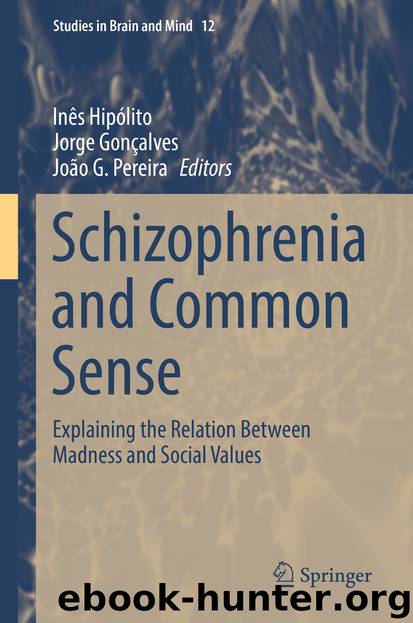Schizophrenia and Common Sense by Inês Hipólito Jorge Gonçalves & João G. Pereira

Author:Inês Hipólito, Jorge Gonçalves & João G. Pereira
Language: eng
Format: epub
Publisher: Springer International Publishing, Cham
The standard Ipseity approach to schizophrenia postulates a two-stage model. In the first stage the primary factors of ipseity disturbance: the triad of diminished self-presence, operative hyperreflexivity and disturbed grip undermine both the subjects sense of self and engagement in the world (Borda & Sass, 2015). These abnormalities are understood as automatic or non-volitional. These primary factors may then tip over into secondary factors known as secondary hyperreflectivity, secondary diminished self-presence and secondary disturbed grip (Sass & Borda, 2015). Sass & Border mainly distinguish these factors with the claim that they have become either volitional or quasi-volitional. Yet, it is far from clear that this explains the development of clinical schizophrenia and especially the production of bizarre beliefs or (to an extent) hallucination. These two just cited papers by Sass and Borda, while adducing many neuroscientific studies that support various aspects of their model, lack an overall framework at the neurocognitive or computational level to really explain and unify their account.
Properly explaining schizophrenia requires a more coherent and, ideally, mechanistic explanation of what ipseity disturbance is in the first place and why these disturbances ramify in the ways that they do. It requires a deeper model of how first-rank symptoms are generated from disturbances in ipseity and presence, and why the original sense of disturbances of presence tends to subside in the psychotic phase. It requires an understanding of the reasons and mechanisms that cause some patient’s disturbances in presence to progress to first-rank psychotic symptoms on the schizophrenia spectrum, while other patients’ problems remain at the level of disturbed presence. I will now turn to the framework of hierarchical predictive processing which offers us important new resources to deal with some of these lacunae.
A really detailed and satisfying explanation would need to show how the symptoms of the prodromal schizophrenia tend toward the development of psychosis and radical thought dismemberment whereas those of DPD do not. To put this another way, why do the apparently radical distortions of thought, presence, sense of self, and self/world boundaries that we already find in DPD not give rise to the sorts of psychotic breakdown we see in full-blown schizophrenia? Might there be other, as yet unexplained, factors that are needed to trigger any transformation to psychosis? Indeed, might there be unidentified factors of resistance to the development of psychosis that might help build future treatments?
In this section I shall examine the hierarchical predictive processing (HPP) approach to explaining the mind and specifically what this can add to the attempt to explain the phenomenology of schizophrenia in both its prodromal and psychotic phases. What follows is a brief introduction to HPP (Clark, 2012, 2015; Friston, 2008, 2010; Hohwy, 2013). This is a new framework for understanding cognition that offers a variety of new perspectives on what the mind is, how it works and, importantly, the ways in which its processing architecture can be disturbed to predict various aspects of mental illness. I will argue that the HPP framework offers a mechanistic explanation of
Download
This site does not store any files on its server. We only index and link to content provided by other sites. Please contact the content providers to delete copyright contents if any and email us, we'll remove relevant links or contents immediately.
Should I Stay or Should I Go? by Ramani Durvasula(7518)
Why We Sleep: Unlocking the Power of Sleep and Dreams by Matthew Walker(6557)
Fear by Osho(4619)
Flow by Mihaly Csikszentmihalyi(4579)
Rising Strong by Brene Brown(4342)
Why We Sleep by Matthew Walker(4317)
The Hacking of the American Mind by Robert H. Lustig(4265)
How to Change Your Mind by Michael Pollan(4256)
Too Much and Not the Mood by Durga Chew-Bose(4229)
Lost Connections by Johann Hari(4003)
He's Just Not That Into You by Greg Behrendt & Liz Tuccillo(3806)
Evolve Your Brain by Joe Dispenza(3572)
The Courage to Be Disliked by Ichiro Kishimi & Fumitake Koga(3352)
Crazy Is My Superpower by A.J. Mendez Brooks(3272)
In Cold Blood by Truman Capote(3269)
Resisting Happiness by Matthew Kelly(3265)
What If This Were Enough? by Heather Havrilesky(3250)
The Book of Human Emotions by Tiffany Watt Smith(3199)
Descartes' Error by Antonio Damasio(3188)
